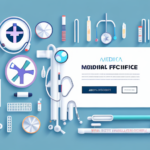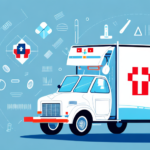Planning Your Medical Supply Delivery Business
Starting a medical supply delivery business is a promising venture, especially given the ongoing growth in the healthcare sector. This business not only offers the potential for profitability but also provides essential support to healthcare facilities and patients. Below are the key steps to guide you through establishing a successful medical supply delivery business.
Why a Medical Supply Delivery Business is a Great Idea
The global healthcare market is expected to reach $11.9 trillion by 2022, driven by an aging population and the prevalence of chronic diseases. According to the World Health Organization, noncommunicable diseases account for 71% of all deaths globally. This surge in demand for medical supplies presents a lucrative opportunity for entrepreneurs.
The COVID-19 pandemic has further accentuated the necessity for reliable medical supply delivery services. With heightened awareness of social distancing and minimizing exposure, many patients prefer home healthcare services, leading to an increased demand for home deliveries of medical essentials. By capitalizing on this trend, you can offer a convenient and safe solution to meet the needs of patients and healthcare providers alike.
Identifying Your Target Market
Defining your target market is the foundational step in launching your business. Your primary customers may include:
- Healthcare facilities such as clinics, hospitals, and nursing homes
- Home healthcare organizations
- Individual patients requiring regular medical supplies, including those with mobility issues or specific medical conditions
- Residents in remote or rural areas with limited access to medical supplies
Partnering with local healthcare providers and insurance companies can also help expand your customer base and enhance your reach.
Conducting Market Research
Comprehensive market research is crucial for understanding the competitive landscape and customer needs. Key components include:
- Competitive Analysis: Identify your competitors, analyze their product offerings, pricing strategies, and marketing tactics to differentiate your business effectively.
- Customer Insights: Understand the preferences, purchasing behaviors, and specific needs of your target audience to tailor your services accordingly.
- Market Trends: Stay updated with industry trends, technological advancements, and regulatory changes that could impact your business.
Leveraging tools like Statista and industry reports from sources such as IBISWorld can provide valuable data to inform your strategy.
Developing a Business Plan
A well-structured business plan outlines your business goals, strategies, and financial projections. Essential elements include:
- Executive Summary: An overview of your business concept, mission, and objectives.
- Market Analysis: Insights from your market research, highlighting opportunities and challenges.
- Organizational Structure: Details about your business’s legal structure, management team, and staffing requirements.
- Services Offered: A comprehensive list of the medical supplies you intend to deliver and any additional services.
- Marketing Strategy: Plans for promoting your business and attracting customers.
- Financial Projections: Detailed forecasts of revenue, expenses, and profitability.
Regularly reviewing and updating your business plan is vital to adapt to changing market conditions and ensure financial viability.
Legal and Regulatory Considerations
Understanding and complying with legal requirements is essential to operate your medical supply delivery business smoothly and avoid potential legal issues.
Choosing the Right Legal Structure
Selecting the appropriate legal structure impacts your taxation, liability, and ability to raise capital. Common options include:
- Sole Proprietorship: Simple to establish but offers no liability protection.
- Partnership: Suitable for businesses with multiple owners but entails shared liability.
- Limited Liability Company (LLC): Provides liability protection and flexible tax options.
- Corporation: Ideal for businesses seeking to raise capital through investors, offering limited liability and potential tax benefits.
Consulting with a legal professional can help you determine the best structure for your specific needs.
Registering Your Business and Obtaining Permits
Once you've chosen a legal structure, register your business with the appropriate state and local authorities. Necessary permits and licenses may include:
- Business License: Required to legally operate your business within your jurisdiction.
- Zoning Permit: Ensures your business location complies with local zoning laws.
- Health Department Permit: Necessary for handling and distributing medical supplies.
- Sales Tax Permit: Enables you to collect sales tax from customers.
Failure to obtain these permits can result in fines or business closure. Visit the Small Business Administration for detailed guidance.
Ensuring Regulatory Compliance
Compliance with regulations such as HIPAA (Health Insurance Portability and Accountability Act), OSHA (Occupational Safety and Health Administration), and DOT (Department of Transportation) is mandatory:
- HIPAA: Protects patient privacy and ensures the secure handling of medical information.
- OSHA: Establishes safety standards to protect employees handling medical supplies.
- DOT: Regulates the transportation of goods, including proper vehicle standards and driver qualifications.
Adhering to these regulations not only avoids legal repercussions but also builds trust with your clients.
Operations Setup
Efficient operations are the backbone of a successful medical supply delivery business. Key aspects include sourcing, logistics, and staffing.
Sourcing Quality Suppliers
Partnering with reliable suppliers ensures that you provide high-quality medical supplies at competitive prices. Consider the following when selecting suppliers:
- Reputation: Choose suppliers with a proven track record for reliability and quality.
- Pricing: Negotiate bulk pricing to reduce costs and improve profit margins.
- Product Range: Ensure suppliers offer a wide range of products to meet diverse customer needs.
Resources like Alibaba and Made-in-China can help you find reputable suppliers globally.
Choosing Delivery Vehicles
Selecting the right vehicles is crucial for efficient and cost-effective deliveries. Factors to consider include:
- Capacity: Ensure vehicles can accommodate the volume and size of medical supplies.
- Fuel Efficiency: Opt for fuel-efficient models to reduce operational costs.
- Maintenance: Choose vehicles known for reliability and low maintenance requirements.
Electric vehicles (EVs) are increasingly popular due to their lower environmental impact and operational costs. According to Energy.gov, EVs can significantly reduce fuel expenses over time.
Hiring Staff
Building a competent team is essential for delivering high-quality service. Key roles include:
- Drivers: Responsible for timely and safe deliveries. Look for individuals with clean driving records and experience in handling medical supplies.
- Dispatchers: Coordinate delivery routes, manage schedules, and handle communication between drivers and customers.
- Administrative Personnel: Manage billing, customer inquiries, and overall office operations.
Investing in employee training ensures that your team adheres to safety standards and provides excellent customer service.
Implementing an Effective Delivery System
An optimized delivery system enhances efficiency and customer satisfaction. Key components include:
- Route Optimization: Use software like Route4Me to plan the most efficient delivery routes, reducing fuel costs and delivery times.
- Scheduling: Implement a scheduling system that allows for flexibility and scalability as your business grows.
- Tracking Technology: Utilize GPS tracking and delivery management software to monitor shipments in real-time, ensuring transparency and reliability.
Effective logistics management not only streamlines operations but also builds trust with your clients by ensuring timely deliveries.
Financial Planning and Funding
Robust financial planning is critical to sustain and grow your business. This includes assessing costs, projecting profits, and securing necessary funding.
Assessing Costs and Profits
Understanding your financial landscape involves evaluating both fixed and variable costs:
- Fixed Costs: Include expenses like rent, salaries, vehicle leases, and insurance.
- Variable Costs: Fluctuate based on sales volume and include fuel, maintenance, and supply costs.
Calculating your break-even point helps determine the minimum sales required to cover costs. Tools like Score’s financial templates can assist in creating detailed financial projections.
Securing Funding
Starting a medical supply delivery business may require significant initial investment. Funding options include:
- Small Business Loans: Available through banks and credit unions. The SBA offers various loan programs tailored for small businesses.
- Grants: Government and private organizations offer grants that do not require repayment. Websites like Grants.gov list available grant opportunities.
- Investors: Angel investors or venture capital firms may provide funding in exchange for equity.
- Personal Savings: Using personal funds can reduce reliance on external financing but may carry personal financial risk.
Choosing the right funding source depends on your business model, creditworthiness, and long-term financial goals.
Marketing and Branding
Effective marketing and strong branding are essential for attracting and retaining customers in a competitive market.
Creating a Brand Identity
Your brand identity distinguishes your business from competitors and fosters customer loyalty. Key elements include:
- Business Name and Logo: Choose a memorable name and professional logo that reflect your brand values and resonate with your target audience.
- Website: Develop a user-friendly website with clear information about your services, contact details, and an online ordering system.
- Social Media Presence: Engage with customers on platforms like Facebook, LinkedIn, and Twitter to increase visibility and interact with your audience.
Consistent branding across all platforms builds recognition and trust among your customers.
Marketing Strategies
Implement diverse marketing strategies to reach potential customers effectively:
- Digital Marketing: Utilize SEO, content marketing, and pay-per-click (PPC) advertising to drive online traffic to your website.
- Networking: Attend industry conferences, join local business associations, and participate in community events to build relationships with healthcare providers and potential clients.
- Referral Programs: Encourage existing customers to refer new clients by offering incentives such as discounts or free services.
- Email Marketing: Send regular newsletters and updates to keep your clients informed about new products and services.
According to the HubSpot Marketing Statistics, businesses that prioritize blogging are 13 times more likely to achieve a positive ROI, highlighting the importance of content marketing in your strategy.
Growth and Expansion
As your business stabilizes and grows, strategic planning for expansion ensures sustained success and the ability to meet increasing demand.
Measuring Success
Tracking key performance indicators (KPIs) helps evaluate your business’s performance and identify areas for improvement. Essential metrics include:
- Revenue Growth: Monitor monthly and annual revenue to assess financial health.
- Customer Satisfaction: Use surveys and feedback tools to gauge customer satisfaction and address any issues promptly.
- Delivery Efficiency: Measure delivery times, accuracy, and reliability to ensure operational effectiveness.
- Profit Margins: Analyze profit margins to ensure pricing strategies are sustainable.
Implementing tools like Google Analytics and customer relationship management (CRM) systems can aid in tracking and analyzing these metrics.
Overcoming Challenges
The medical supply delivery industry comes with its set of challenges, including:
- Supply Chain Disruptions: Develop strong relationships with multiple suppliers to mitigate the risk of shortages or delays.
- Regulatory Changes: Stay informed about changes in healthcare regulations to ensure ongoing compliance.
- Technological Advancements: Invest in the latest delivery and tracking technologies to maintain efficiency and competitiveness.
Having contingency plans and a proactive approach to problem-solving can help navigate these challenges effectively.
Planning for Expansion
Scaling your business to meet growing demands involves careful planning and resource management:
- Service Diversification: Expand the range of medical supplies offered or introduce additional services like home healthcare consultations.
- Geographical Expansion: Enter new markets by extending your delivery services to different regions or states.
- Technology Integration: Implement advanced logistics and inventory management systems to handle increased operational complexity.
- Staffing: Hire additional staff to maintain service quality as your customer base grows.
Strategic expansion ensures that your business can sustain growth without compromising on quality or customer satisfaction.
Providing Exceptional Customer Service
Exceptional customer service is pivotal in building trust and loyalty, leading to repeat business and positive referrals.
Building Trust and Loyalty
Focus on the following to enhance customer satisfaction:
- 24/7 Availability: Ensure your customer service team is accessible around the clock to address inquiries and resolve issues promptly.
- Efficient Communication: Maintain clear and consistent communication regarding order status, delivery times, and any potential delays.
- Empathetic Service: Train your staff to handle customer interactions with empathy and professionalism, especially when dealing with patients' sensitive needs.
Implementing a robust customer support system, including live chat and dedicated helplines, can significantly enhance the customer experience.
Conclusion
Launching a medical supply delivery business requires meticulous planning, a deep understanding of the healthcare market, and a commitment to quality and compliance. By following this comprehensive guide—conducting thorough market research, establishing a solid operational foundation, ensuring legal compliance, and implementing effective marketing and customer service strategies—you can build a successful and impactful business. As the demand for medical supplies continues to grow, your business can play a crucial role in supporting healthcare providers and improving patient outcomes, while also achieving financial stability and growth.






















